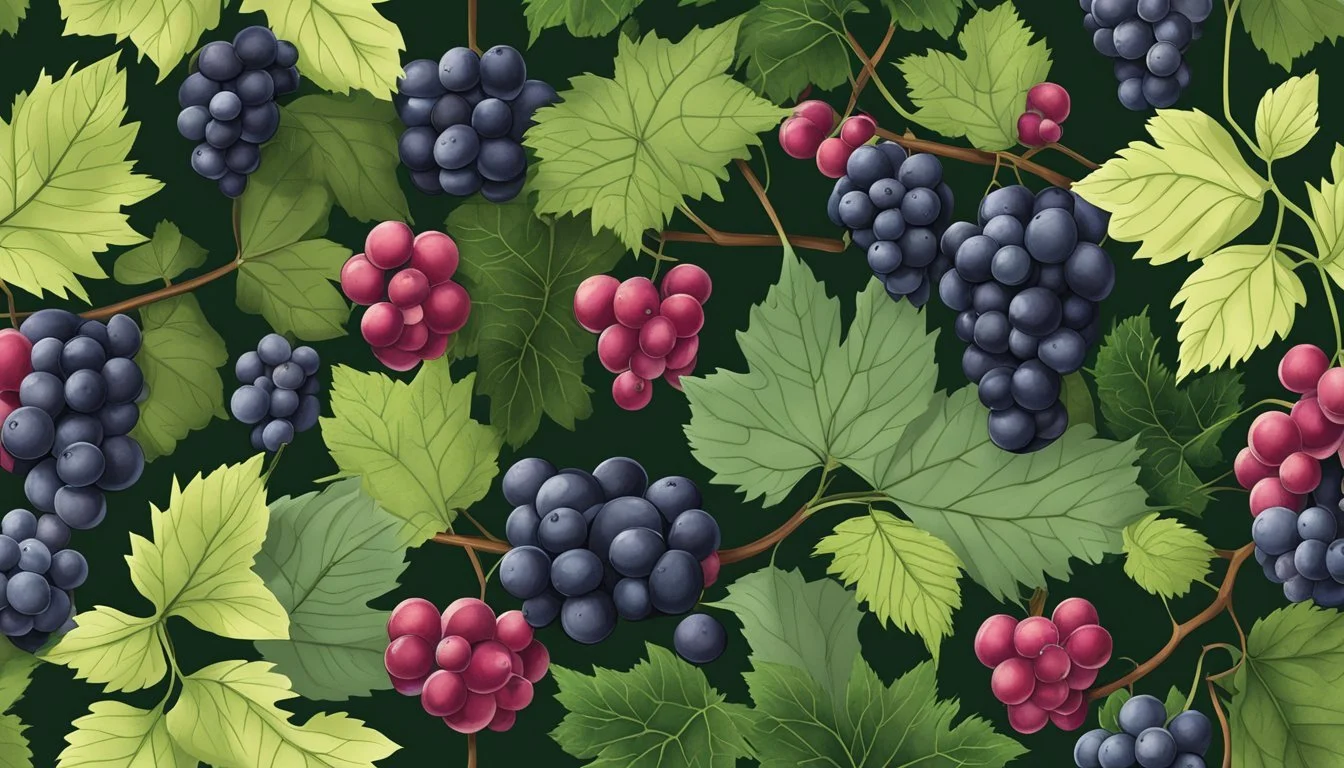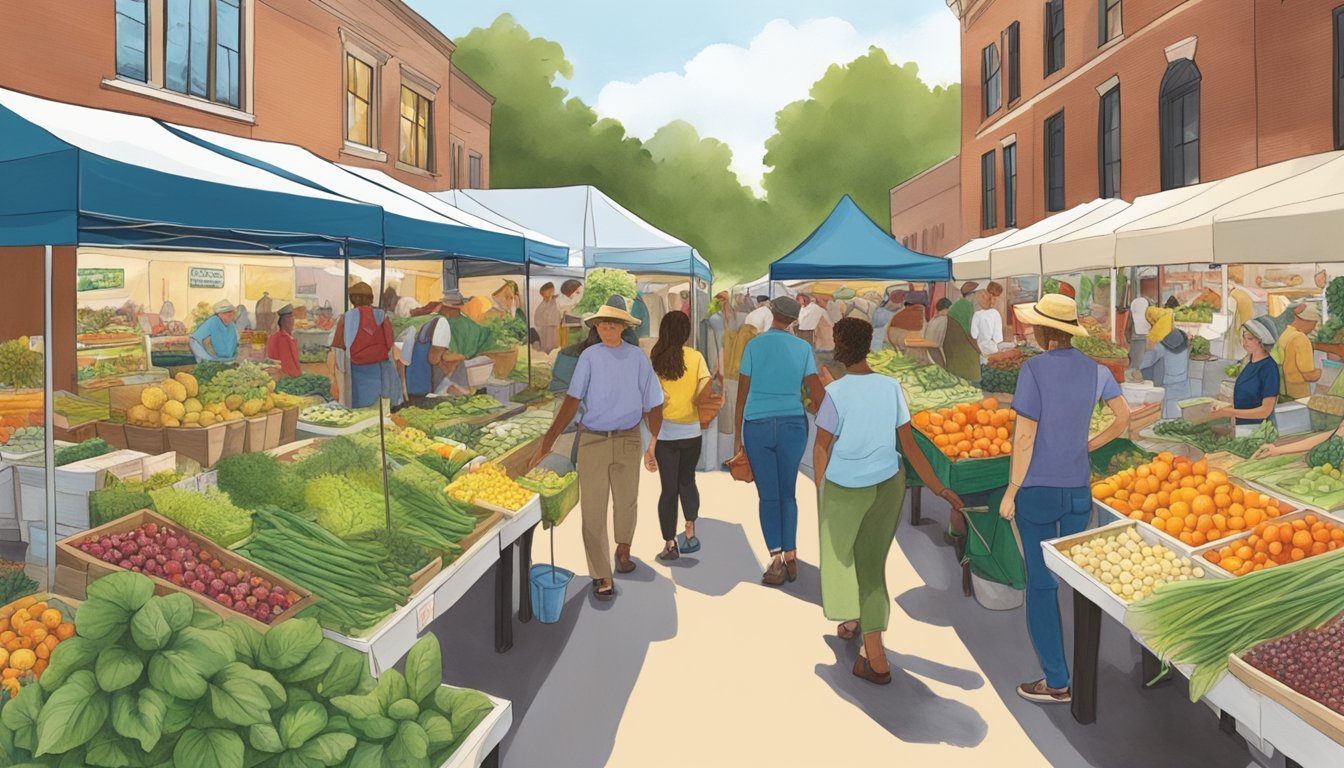Native Edible Plants in South Carolina
A Guide to Foraging Local Flora
This Article is Part of Foraging Guide for All 50 US States
South Carolina’s diverse ecosystems, ranging from the Blue Ridge Mountains to the Atlantic coastal plains, harbor a wealth of native plants, many of which have edible parts. The state’s indigenous flora includes a variety of trees, shrubs, herbs, and vines that have served as food sources for local wildlife and humans alike for centuries. These plants not only offer a connection to the state’s natural heritage but also provide opportunities for contemporary foraging, gardening, and landscaping with native species.
Among these edible natives are fruit-bearing trees like the pawpaw, persimmon, and muscadine grape which have been traditionally harvested for their sweet and nutrient-rich offerings. The understory provides its bounty as well with species such as the highbush blueberry and the American beautyberry. These plants have adapted over time to South Carolina’s climate and soil conditions, requiring less maintenance than non-native species and serving as important components of local ecosystems by supporting pollinators and wildlife.
The culinary use of these plants is matched by their cultural significance. Many native tribes and early settlers relied on these species for sustenance and medicinal purposes. Present-day interest in local and sustainable food sources has fostered a renewed appreciation for these native edibles. For those interested in exploring the flavors of South Carolina’s wilderness, an abundance of resources can guide safe and sustainable foraging practices, ensuring that these plant populations thrive for future generations to enjoy.
Interested in Mushroom Hunting in South Carolina?
South Carolina's lush forests and warm, humid climate provide an ideal environment for a variety of edible mushrooms. The state is home to several sought-after species, including chanterelles, oyster mushrooms, chicken of the woods, and morels. The best time to hunt for mushrooms in South Carolina depends on the species and location, but generally falls between spring and fall. The Francis Marion National Forest and other state parks offer prime spots for foraging. As with any mushroom hunting adventure, proper identification skills and respect for the environment and private property are essential for a safe and enjoyable experience in South Carolina's beautiful natural areas.
👉 Guide on Mushroom Hunting in South Carolina
Understanding South Carolina's Ecosystem
South Carolina's ecosystem is rich in diversity with a myriad of native plants that play a critical role in the health and sustainability of local habitats. The complex interaction between soil conditions, wildlife, and environmental factors contribute to this varied botanical landscape.
Forests and Habitats
South Carolina's forests range from the coastal plains to the Blue Ridge Mountains, encompassing pine savannas, mixed hardwoods, and cypress swamps. These habitats are not only diverse in their plant species but also support a wide array of wildlife. Pine forests with their open understories are conducive to the growth of various ground covers and herbaceous plants that are edible and often hold cultural significance.
Soil Conditions and Plant Diversity
The soil in South Carolina varies greatly, from the sandy soils of the coastal regions to the rich, loamy soils of the Piedmont and the clay of the Upstate. Each soil type influences the kind of plant life that can thrive there. Acidic soils in the pine forests promote the growth of certain berry-producing shrubs, while the rich riverine soils are suitable for a variety of fruiting trees and plants.
Wildlife-Plant Interactions
Wildlife such as birds, bees, insects, squirrels, raccoons, and turkeys form intricate relationships with South Carolina's native plants. Bees pollinate flowers, leading to fruit development, while birds disperse seeds (how long do seeds last?) through their droppings, facilitating plant propagation. Squirrels and raccoons are known to be seed dispersers as well as predators, occasionally affecting the population dynamics of some plant species.
Environmental Considerations
South Carolina's environment is currently facing challenges such as urban sprawl, deforestation, and climate change. These factors can adversely affect native plant species and their habitats. Conservation and sustainable practices are essential to preserve the natural diversity and ensure that the edible plants continue to be a resource for future generations. Protecting natural areas and supporting local wildlife are key steps in maintaining the balance of South Carolina's unique ecosystem.
Native Edible Plant Species
South Carolina's landscape offers an array of native plants, many of which provide edible fruits, nuts (how long do nuts last?), and roots. These species have adapted to the region's climate and soils, offering sustenance for wildlife and humans alike.
Deciduous Trees and Their Fruits
Persimmon (Diospyros virginiana): This deciduous tree bears sweet, flavorful fruits that can be eaten raw after they ripen to a soft texture, or used in jellies and desserts.
Mulberry (Morus spp.): Mulberries produce elongated fruits similar to blackberries, commonly used for making preserves and baked goods when they turn deep purple or red in color.
Evergreen Varieties and Nuts
Hickory (Carya spp.): Native hickory trees like the Pignut (Carya glabra) and Mockernut (Carya tomentosa) provide hard-shelled nuts renowned for their rich flavor.
Pine (Pinus spp.): The Longleaf Pine (Pinus palustris) offers not only edible seeds in its cones but also the inner bark, which can be consumed in survival situations.
Berry Producing Shrubs and Plants
Blueberry (Vaccinium spp.): Several native species like the Highbush Blueberry (Vaccinium corymbosum) thrive in South Carolina, yielding berries eaten fresh or used in culinary dishes.
Hawthorn (Crataegus spp.): The fruits of the Hawthorn tree, resembling small apples, can be harvested and made into jellies or snacks.
Herbaceous Plants and Roots
Chickweed (Stellaria media): Regarded as a weed by some, chickweed offers tender greens that are edible raw or cooked, often used in salads.
Sassafras (Sassafras albidum): This plant is famous for its distinct, aromatic roots that are traditionally used to flavor beverages like root beer.
Amelanchier arborea (Amelanchier arborea): Commonly known as the Serviceberry, its fruits resemble blueberries and can be enjoyed raw or in various recipes.
Foraging Best Practices
Foraging for native plants in South Carolina is an enriching way to connect with the local ecosystem, but it requires careful practice to ensure sustainability and safety.
Identifying Edible Species
A successful forager must first have in-depth knowledge of the plant species they are seeking. It is crucial to consult field guides or work with a knowledgeable botanist to accurately identify edible species. Mistaking a plant for an edible counterpart can be dangerous, as some plants are toxic.
Visual Inspection: Cross-reference multiple features such as leaf shape, color, and growth patterns.
Seasonal Variations: Be aware that some plants can look different depending on the season.
Avoid Unknowns: If there is any uncertainty, do not consume the plant.
Harvesting Without Harming
The principle of sustainable foraging is to harvest without causing long-term damage to natural habitats. Collecting practices should ensure that plants can regenerate.
Take Only What You Need: Forage in moderation, leaving enough for wildlife and regrowth.
Respectful Approach: Always tread lightly at foraging sites to avoid damage to surrounding flora.
Seed Dispersal: Consider dispersing seeds of the plants being harvested to encourage growth.
Seasonal Foraging Calendar
Knowledge of the seasonal availability of various fruits, nuts, and seeds ensures that foraging activities align with natural cycles.
Season Items Likely Available Spring Young greens, herbs Summer Berries, fruits Fall Nuts, late fruits Winter Roots, bark
Foragers should research and document the specific peak seasons for each plant they intend to harvest in their locality, as timing can vary from one environment to another.
Cultivation and Propagation
Successfully cultivating and propagating native edible plants in South Carolina involves understanding regional soil conditions and specific agricultural practices. This section provides insight into acquiring local plant varieties and offers guidance for growing these plants.
Native Plant Nurseries and Seed Banks
Native plant nurseries and seed banks in South Carolina serve as crucial resources for gardeners and farmers seeking to cultivate local edible plants. These establishments specialize in propagating plants that are adapted to the state's climate and soil conditions, ensuring a greater chance of cultivation success.
Location and Contacts: A directory is available for individuals to locate nurseries and seed banks within their vicinity.
Plant and Seed Availability: These centers offer a diverse selection of native edible plant seeds, including fruits, nuts, and herbs that are suited for South Carolina's agricultural zones.
Growing Edible Plants at Home
For those interested in backyard farming or urban agriculture, growing native edible plants at home begins with understanding the soil conditions and climate of South Carolina.
Soil Preparation: Optimal soil conditions vary among plant species, but well-draining, fertile soil is generally recommended for most native edibles.
Planting Techniques:
Direct sowing: Some species prefer direct sowing where seeds are planted directly into the ground.
Starts and Transplants: Others may require starts that are first grown in controlled conditions and then transplanted outdoors.
Maintenance: Regular maintenance, such as watering, pruning, and pest control, is essential for a healthy and productive garden or farming experience.
Wildlife and Plant Relationships
In South Carolina, native plants provide essential resources for local wildlife, sustaining a complex web of interactions that uphold the ecosystem.
Pollinators and Seed Dispersal
Pollinators such as bees, butterflies, including the Zera Swallowtail, and hummingbirds are vital to the health of native plants. They facilitate the reproduction of plants by transferring pollen, leading to fruit and seed production. In South Carolina, the relationship between native plants and their pollinators is tightly knit, with many plants depending on specific pollinator species.
Seed dispersal is another critical function provided by wildlife. Birds including the bluebird, robin, mockingbird, and blue jay consume the fruits of native plants and subsequently disperse the seeds through their droppings. This natural process aids in the propagation of native species, ensuring their spread across different habitats.
Wildlife Foraging and Habitat
Native plants serve as a primary food source for various game birds such as bobwhite quails. Their sustenance on seeds, berries, and insects found among these plants is crucial for their survival. Additionally, these plants offer shelter and nesting materials, fulfilling the habitat requirements for a multitude of species.
Foraging behavior has profound impacts on the plant life and ecosystem dynamics. For instance, the selective feeding habits of some species can influence the composition and future growth patterns of native vegetation. Through foraging, wildlife contributes to the health and maintenance of habitats, ensuring that South Carolina's ecosystems remain robust and vibrant.
Conservation and Environmental Impact
The sustainable management and preservation of South Carolina's native edible plants are crucial for maintaining diverse habitats and supporting local wildlife.
Indigenous Plant Protection
Protection Efforts: South Carolina implements conservation strategies to protect indigenous plants, including those that are edible. These strategies often involve:
Legal protection: Laws to prevent overharvesting and land misuse.
Environmental education: Programs for the public to understand the importance of native species.
Habitat conservation: Efforts to maintain and restore natural environments.
Local communities and conservation groups play a vital role in sustaining native plant species, often working in tandem with governmental agencies to enforce regulations and manage restoration projects.
Impact on Local Wildlife
Interconnected Systems: Native plants form a foundational part of the ecosystem, offering nourishment and habitat for local wildlife.
Wildlife Beneficiaries Plant Contribution Bees and Butterflies Nectar and pollen sources for foraging. Birds Fruits, seeds, and cover for nesting. Mammals Varied plant parts for food and shelter.
The destruction or decline of indigenous edible plants can lead to a disruption in the food web. Their conservation is essential not only for the environment but also for the wildlife that depends on these plants for survival.
Uses of Native Plants
Native edible plants in South Carolina serve a multitude of uses, from health benefits to culinary enhancements. They offer both nutritional value and aesthetic appeal in landscaping.
Nutritional and Medicinal Applications
Native plants like the Pawpaw (Asimina triloba) and Yaupon Holly (Ilex vomitoria) are rich in vitamins and antioxidants. Pawpaw, with its high protein content, can contribute to a balanced diet. It is also known for its anti-inflammatory properties. The leaves and bark of Yaupon Holly, meanwhile, have been used for their caffeine content and medicinal purposes, including as a traditional remedy for various ailments.
Pawpaw:
Nutrients: Protein, Vitamin C, Magnesium, Iron
Medicinal: Anti-inflammatory, Antioxidant
Yaupon Holly:
Health Uses: Caffeine source, Digestive aid
Medicinal: Antioxidant properties, Mild stimulant
Culinary Delights from Nature
Indigenous flora such as the Muscadine grape (Vitis rotundifolia) and the American Persimmon (Diospyros virginiana) are used to create flavorful jellies, jams, and beverages. These plants not only add a unique touch to the cuisine but also enhance it with natural sweetness and nutrients.
Muscadine Grape:
Cuisine: Jellies, Jams, Wines
Taste Profile: Sweet, Robust
American Persimmon:
Cuisine: Desserts, Puddings, Syrups
Taste Profile: Honey-like, Rich
Landscaping with Native Flora
In backyard landscaping, native plants such as the Southern Magnolia (Magnolia grandiflora) and the Carolina Jessamine (Gelsemium sempervirens) are valued for their beauty and low maintenance. They thrive in South Carolina’s climate and provide habitat for local wildlife.
Southern Magnolia:
Landscaping Features: Evergreen foliage, Large white flowers
Uses: Aesthetic appeal, Shade provider
Carolina Jessamine:
Landscaping Features: Yellow flowers, Vine growth habit
Uses: Natural fencing, Ornamental display
Community and Economic Aspects
The inclusion of native edible plants in South Carolina's community and economy nurtures local agriculture, bolsters educational efforts, and enriches cultural practices. These plants offer both tangible and intangible benefits, from commercial opportunities to the preservation of historical traditions.
Support for Local Farmers and Markets
Local farmers and markets benefit economically by integrating South Carolina native edibles into their offerings. Markets provide consumers with authentic state flora, like the Columbine (state flower), which garners attention and supports biodiversity. Purchase of these natives aids in the circulation of revenue within the state, reinforcing the local economy and community.
Plant Sales: Markets often host plant sales, featuring indigenous edibles that are increasingly sought after for their local adaptability and nutritional value.
Livestock Feed: Some native plants can serve as feed for livestock, potentially reducing costs for farmers, and promoting a more sustainable agricultural practice.
Educational Programs and Societies
Educational programs and societies such as the South Carolina Native Plant Society (SCNPS) play a crucial role in spreading knowledge about the state's edible flora. They facilitate workshops and educational outreach programs that teach identification, cultivation, and the nutritional benefits of these plants, strengthening the community's connection to the environment.
Workshops
Outreach programs
Cultivation guides
Plant Sales and Exchanges
Community plant sales and exchanges encourage the propagation of native edibles, supporting both economy and education. Local nurseries often collaborate with organizations like the SCNPS to supply a diverse range of plants. These events help to maintain genetic diversity and foster a localized agricultural scheme.
Nurseries: Nurseries profit by offering a selection of native edible plants, contributing to both their business growth and local biodiversity.
Exchanges: Exchanges among community members enhance the spread of plant knowledge and foster neighborly relationships.
Cultural Significance of State Flora
The state's flora, especially edibles, holds a profound cultural significance in South Carolina. They are emblematic of the state’s identity and contribute to its culture and history. The Columbine, for example, does more than beautify gardens and landscapes; it serves as a symbol of the state’s natural heritage.
Cultural identity: Native edibles are part of South Carolina's unique cultural identity.
Historical narratives: These plants are intertwined with stories and practices dating back to early indigenous populations.
Wild Edible Plant Traditions
Traditions surrounding wild edible plants are woven into the fabric of South Carolina's history and culture. These traditions include foraging practices passed down through generations, which bolster the community's self-sufficiency and connection to their natural surroundings. They embody not just food sources but also a form of living heritage vital to the identity of the state’s communities.
Foraging Practices: Continuation of traditional foraging practices supports a living connection to the land and the past.
Community Events: Events centered around native edibles, such as festivals and cook-offs, reinforce community bonds and celebrate local cuisine.
Further Reading and Resources
For those looking to expand their knowledge on native edible plants in South Carolina, a variety of resources are available. Enthusiasts and educators alike can benefit from the detailed accounts and guides written by expert botanists.
Books and Guides:
"Edible Wild Plants: A North American Field Guide" by Thomas Elias and Peter Dykeman provides comprehensive information, including detailed illustrations for plant identification.
"Wild Edibles: A Practical Guide to Foraging" by Sergei Boutenko, offers insights into foraging techniques and the nutritional value of plants.
Organizations:
South Carolina Native Plant Society (SCNPS): This organization is a valuable resource for individuals interested in native plants. They offer field trips, meetings, and lectures that enhance education on native flora.
Website: SCNPS
Online Resources:
Articles published by academic institutions such as Clemson University's Cooperative Extension offer credible information on local edible plants.
Seed Banks and Nurseries:
Local nurseries can provide seeds and seedlings of South Carolina’s native plants for personal gardens, offering a hands-on approach to learning.
Workshops and Classes:
Botanical gardens and local community colleges often host workshops focusing on indigenous plants that include both classroom and field experiences.
Databases:
The USDA Plants Database is a reliable source for botanical information, including a wealth of details on plant species occurring in South Carolina.
Conclusion
South Carolina is home to a diverse range of native edible plants, each offering unique flavors and nutritional benefits. The exploration of these plants reflects not only a growing interest in local and sustainable food sources but also a recognition of traditional ecological knowledge.
Prospects for the Future:
Research into the culinary and medicinal uses of these plants has room for growth. There is potential for increased cultivation and integration into local cuisine, which can offer economic opportunities while promoting biodiversity.
Reflections on Learning:
Educational efforts can enhance the understanding and appreciation for these native species. There is a significant opportunity for schools and local organizations to introduce programs that inform the public about the safe and sustainable use of these plants.
Summary of Importance:
The edible plants of South Carolina are more than just food; they connect communities to their environment and heritage. By recognizing the value of native species, residents can contribute to conservation efforts and foster a healthier ecosystem.
Future studies and conservation programs should continue to prioritize the protection of these plants and their habitats, ensuring that they remain a viable resource for generations to come.







